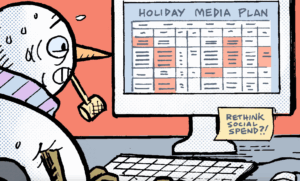When eBay launched 22 years ago as an auction platform where buyers bid on used items, it disrupted online shopping.
But as consumer shopping habits evolved and ecommerce became table stakes, eBay’s brand and marketing strategy needed a refresh to compete with new entrants.
Despite tough competition and a slow pivot to ecommerce, eBay’s revenues grew 9% last quarter to $2.4 billion, and the platform added 2 million active buyers in Q3, hitting 96 million monthly visitors, according to Statista. (Amazon had 183 million monthly users in Q3.)
“Customer expectations have gone well beyond [the company’s past identity],” said Karl Isaac, VP of global brand at eBay. “There’s a lot of things people don’t know. They think of us as the original eBay, but we’ve changed.”
EBay has expanded its access to new inventory, opened new ways consumers can buy and implemented policies around money-back guarantees and making shipping and returns easier, Isaac said.
On the marketing side, eBay has spent the past few years restructuring its data and experimenting with new ad formats and media platforms to reach consumers.
“We’re trying to create more personal, relevant experiences so people can find what’s right for them,” Isaac said. “Data plays a huge role in that.”
He spoke with AdExchanger.
AdExchanger: How did restructuring your data improve your marketing efforts?
KARL ISAAC: How we use and structure data [helps us] understand inventory on eBay and serve it up in more personalized, simple and relevant ways. That can be as simple as a home page [with] personalized offers. You’re not just going to [see] that one camera someone might be selling; you can compare brands and models. It’s a very different approach than how eBay originally started.
We use machine leaning to serve real-time email offers. When you open the email, we make sure the offer is there and it’s what’s most relevant for you.
How would you describe eBay’s digital strategy?
We’re gathering insights around shopper experiences, what they’re interested in and what might be most relevant to them. We’re going where our customers are. We’re on 20 social channels and we’re experimenting.
We created ShopBot, which serves up eBay inside Facebook Messenger. You can say, “I want to go camping in June in Tahoe with my wife.” Now our data understands the intent, the material and the weather. Or you could say, “I want a leather Coach messenger bag for under $100.”
We have image search recognition. You can snap a picture of something and find it on eBay. That, to me, is a modern shopping experience.
What’s your programmatic strategy as a buyer?
We’re using data and machine learning to make sure we’re serving the right content, experiences and offers and optimizing the creative through feedback loops.
If we’re seeing something perform really well, we can increase the visibility. If something isn’t performing as well, we can optimize the creative. We’re maximizing the potential of data but not for efficiency of the media buy. It’s because of our desire to create simple and personalized experiences for customers.
What kind of talent are you looking for as you enter this new phase as a brand?
People that can understand customer behavior and data and remain empathetic to the needs of customers.
Some fundamental skills haven’t changed, like storytelling and the ability to connect with people in authentic ways. But a lot of the tools of have changed. You need to bring customer insights into the equation.
We’ve moved from an era of protecting, policing and enforcing to collaborating with customers and partners and creating more open experiences. We’ve opened some APIs. WikiBuy, for example, can tap into our API to [power] price comparison shopping.
This interview has been edited.















